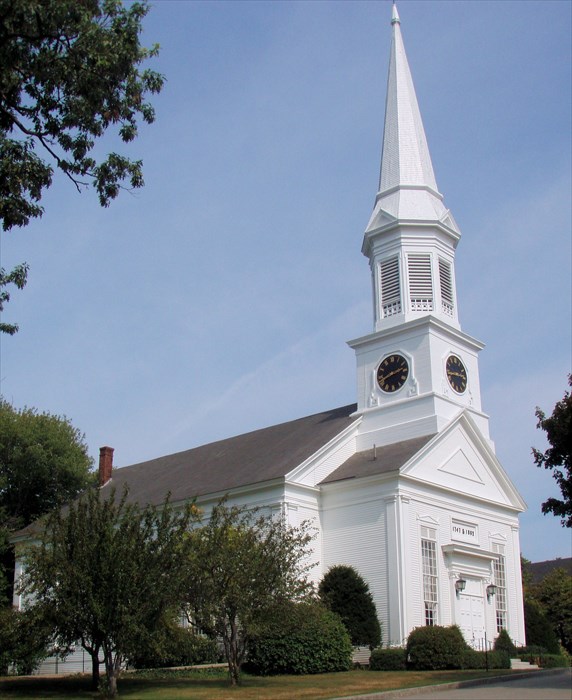
This, the fourth building erected by the congregation, was built in 1747, but the soaring steeple with its belfry and clock weren't added until 1882, probably designed by Samuel Sewall of York. Although in many ways typical of classic New England steeples that often have a clock and belfry, this one is proportionately large, dominating the relatively short height of the church - more steeple than church, it seems.
The steeple, clock, and belfry underwent recent restoration in 2011 by Preservation Timber Framing, which has some wonderful photos of the unveiling of the completed work.
During the 375 year history of this parish, many changes have taken place. Founded in 1636 in the Anglican tradition, the tide began to change as the Puritan congregational movement swept through the colonies. By 1673, Rev. Shubael Dummer was installed as pastor and the congregational form of government was adopted, breaking their old ties. In 1957 the congregation became affiliated with the United Church of Christ, retaining its congregational style. Reference: First Parish Church Brochure.
The following history is from the official web site of the First Parish Church
The First Meetinghouse
In 1636, an oratory (as a meetinghouse was then known) was erected on land granted to Sir Ferdinando Gorges for the purpose of worship according to the Church of England, as required by Charles I, in a Royal Charter to Gorges in this place then called Agamenticus. It was located in York Harbor, near the site of St. George’s Episcopal Church today. The size, material, and design of this building are not known.
The Second Meetinghouse
Completed in August of 1667, the second meetinghouse measured 40 feet by 28 feet with a turret on top. All new materials were used in construction, with the exception of the seats from the previous meetinghouse. The price of this building was 120 English pounds. It was built on "land given to the use of the ministry", part of it a glebe granted by Governor Edward Godfrey as early as 1641, a trust, he said in 1657 in a paper to the Council of State, London, for the maintenance of a "house for the worship of God and endowment of minister." It was along what is now Lindsay Road. In 1673 the Church was organized after the Congregational tradition and remains in that tradition in affiliation with the United Church of Christ.
The Third Meetinghouse
By 1710, the second meetinghouse was deemed unsafe and out of repair. A special town meeting was held where it was decided to build a new meetinghouse. It was to be 50 square feet and sit on the north side of the (old) burying ground. It was also voted to raise the funds through a free will offering and if there was not sufficient money raised that way then the funds were to be raised by a town tax. It is not know if the town tax was needed, but it is a pleasant thought! It was completed in 1712.
In Colonial times the church, or meetinghouse, as it was known, was used for civic as well as ecclesiastical purposes. Public meetings were held there. It also served as the courthouse for the county, and the meeting place for the provincial government.
The Fourth Meetinghouse
On April 19, 1744, it was voted, "that there be a meetinghouse built in this Parish, by subscription, of 70 feet long, 50 feet wide, and 25 feet stud, and sett in the same place where the old meetinghouse now stands." Plans for this meetinghouse lagged as Rev. Samuel "Father" Moody was absent from York, serving as chaplain with the troops on the Louisburg Expedition. On March 25, 1747, the Parish voted again to build a new meetinghouse adding to the former vote, "that there shall be a steeple built at one end." The steeple was most probably designed by Samuel Sewall, Esq., of York. The Parish voted to tear down the third meetinghouse, and, "to use such stuff and materials as will answer." The project was overseen by Rev. Moody, who laid its cornerstone and who lived to see its completion just prior to his death in November, 1747.
When the church was constructed it faced west where the Parish House now sits. In 1882 it was decided that it would look better facing the road, which was not there when the church was originally built. So, the church was lifted up, turned, and set back 20 feet to its present location, where it stands today as a glorious house of God. The Church was restored to the simplicity and beauty of the late Colonial period of church architecture n 1951.